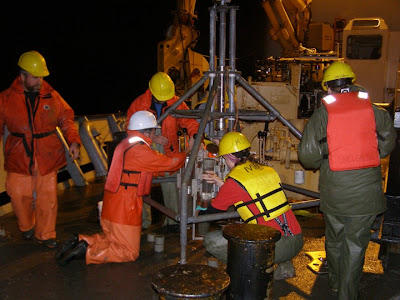

To finish off the blog, on our last day, after our last dive we thought we’d write a little about one of the aspects that made this research cruise so special - ROPOS and their crew. ROPOS which is short for the Remotely Operated Platform for Ocean Science is an extraordinary, highly technical underwater vehicle that comes with an incredibly talented group of guys able to operate and maintain it. Their job is most certainly the envy of many, as since 1996 the ROPOS has visited and recorded high-definition imagery of 21 major mid-ocean and black-arc ridges, 31 major ecological and biological surveys and 95 gas hydrate subduction zone dives!! The ROPOS crew (along with their satellite radio blasting anything from Marilyn Manson to Celine Dion) were fantastic to work with. Not only because ROPOS and it’s supporting equipment is state of the art (including 15 computers and 23 computer and TV monitors packed into one small room), but the crew are true professionals with amazing technical skills that are only enhanced by their adaptability, brains, sense of humour and general can-do attitude.
This is the crew’s fifth week offshore, a longer trip in comparison to their average deployments. Some of the crew have been around since the dawn of ROPOS, in 1986, although the ROPOS has since been significantly upgraded with it’s most recent re-fit completed in 2005.
When these guys are not at sea, Keith Tamburri (assistant manager, electrical & robotics technologist), Ray Morgan (imaging and navigation guru), and Reuben Mills (mechanical technologist) work back at their shop in Victoria, BC with their colleagues who also go to sea, but didn’t on this trip (Keith Shepherd, Ian Murdock, Roger Adamson, Jonathan Lee, Andy Fines, Jason Williams and Yvonne Baier). Another crew member with us, Vincent Auger, goes back to Halifax, Nova Scotia where he’s recently moved and works remotely as a navigation, IT and programming specialist. Last, but certainly not least, were Dan Cormany (Oregon) and Steve Bucklew (California) who only work offshore.
We would like to thank them for all their hard work, dedication and enthusiasm, and for providing us with a window to the deep sea!







































